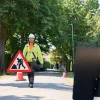Disputes Over UK Street Furniture Risk Slowing 5G Mobile Rollout UPDATE
The next generation of multi-Gigabit speed capable 5G based mobile broadband networks could be facing yet another challenge due to a backlog of disputes over access to UK street furniture (lampposts etc.). Related deployments in some parts of the country are allegedly being delayed by as much as 2 years.
It’s not unfair to say that the tentative roll-out of 5G mobile networks in the United Kingdom has already faced a number of significant challenges and that’s before it’s even fully begun. So far we’ve had the Government’s widely reported, albeit not yet officially confirmed, move to ban Chinese technology giant Huawei from core networks (here). Not to mention disputes over Ofcom’s future spectrum auctions and coverage obligations (here).
At the end of last year we also warned that disputes over wayleave (access) agreements and related rents for building and land access were threatening to become toxic (here). Now a related problem appears to have reared its head after The Guardian revealed that the battle for control of street furniture, which is useful for installing small cells that can help mobile operators to expand their coverage, is threatening to delay the 5G rollout.
Advertisement
In urban areas 5G requires a denser network architecture than 4G in order to deliver its best performance. As a result mobile operators (EE, Three UK, O2 and Vodafone) are all hunting for places to install their kit and public street furniture, such as lampposts (also used for CCTV, WiFi Hotspots, EV car chargers and environmental sensors etc.), are an obvious target.
However cash-strapped councils and landlords are well aware of this demand. Some mobile operators now feel as if those groups are seeking to charge too much for the use of street furniture. BT has also raised concerns over the fairness of existing concession agreements (here) and are arguing for fair access.
The reformed Electronic Communications Code (here) was supposed to resolve such issues, not least by making it easier and cheaper for telecoms operators to access land / property in order to help them build new networks. The new ECC also introduced a tribunal system to help tackle disputes but this has since become so backlogged that new cases may not even get a hearing date until sometime next year.
Theo Blackwell, London’s Chief Digital Officer, said:
“Whilst the intention of the code was to make it easier and cheaper for MNOs to roll out infrastructure, by not providing guidance nor seeking compromise, the government have in fact delayed deployments by two years, whilst the new code is being tested in the courts.”
Interestingly the report notes that sparsely populated rural areas have the opposite problem and are struggling to attract mobile operators to use their own street furniture, although this is hardly a surprise. Installing small cells on top of lampposts (may require a fibre optic feed too) isn’t cheap and thus the economics only make sense in dense urban areas with a lot of nearby foot traffic (the cells have very limited coverage).
Advertisement
In rural areas it would be far more effective to allow the use of taller masts, which could deliver better coverage and is already fairly common around much of the rest of Europe (50 metres). However, despite allowing huge wind turbines, the law still tends to limit the height of masts to 25 metres in England (even less in other parts of the UK).
One other issue here is that you can only fit so much kit on top of a lamppost before it ruins the cosmetic appeal, which becomes more of an issue when you have several interested parties fighting over the same space. Network / infrastructure sharing agreements could help to resolve some of this, if they can be agreed, but as above that’s only one part of the challenge.
Mobile operators recently made a number of proposals for how the UK’s local authorities could help to support their rollout of 5G services (here).
UPDATE 21st May 2019
Advertisement
The Government, which reaffirms that disagreements over interpretation of the legislation are a matter for the courts, has kindly provided us with a comment.
A DCMS Spokesperson said:
“We are working with local authorities and industry to help facilitate mutually acceptable agreements regarding the use of local authority assets for the deployment of 5G.
The Upper Tribunal has recently made a series of rulings that will help settle the market, and we are pleased that deals are now being completed under the new Code.”
Over the longer term they still expect the reformed ECC to provide a strong framework that will support the deployment of future digital infrastructure.
Mark is a professional technology writer, IT consultant and computer engineer from Dorset (England), he also founded ISPreview in 1999 and enjoys analysing the latest telecoms and broadband developments. Find me on X (Twitter), Mastodon, Facebook, BlueSky, Threads.net and Linkedin.
« £200m UK Rural Gigabit Broadband Connectivity Programme Starts


















































Comments are closed